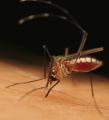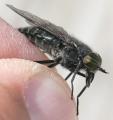Diptera.info :: Miscellaneous :: General queries
Who is here? 1 guest(s)
|
Storing flies in alcohol
|
|
| John Bratton |
Posted on 06-11-2007 18:25
|
|
Member Location: Menai Bridge, North Wales, UK Posts: 654 Joined: 17.10.06 |
When you take them out the alcohol, try to arrange them on the tissue paper with the wings stuck to each other above the flies back. It helps if you pick them out by their feet so that the wings are the last part to leave the alcohol. Then when it has dried, maybe 30 minutes later, take a pin, insert it between the wing bases, and gently move it towards the wing tips so that it breaks the seal between the wings. With luck, they will spring apart but stay straight. John Bratton |
|
|
|
| jorgemotalmeida |
Posted on 07-11-2007 19:48
|
|
Member Location: Viseu - PORTUGAL Posts: 9296 Joined: 05.06.06 |
crex wrote: Thanks again for all input on this subject. Specially to Adrian. Adrian, what size of microtubes (vials) do you use and do you also (as Paul) keep only one speciemen per vial? About the transparent vials. Is it possible to examine the specimen through the "glass" or do you need to take it out of the vial? jorgemotalmeida wrote:... And we can buy 1000 vials for 45 euros.... Where?In Lisbon. The firm calls Vreis, They don?t have a website!  But there is just this: http://www.guiane...file/vreis But there is just this: http://www.guiane...file/vreisThey sell ONLY if we go there! You can try to write to them (email in the link I've sent). Maybe they can help with your request. I'm not sure if they have an international service. |
| cosmln |
Posted on 07-11-2007 21:15
|
|
Member Location: Romania Posts: 956 Joined: 18.03.07 |
jorgemotalmeida wrote: crex wrote: Thanks again for all input on this subject. Specially to Adrian. Adrian, what size of microtubes (vials) do you use and do you also (as Paul) keep only one speciemen per vial? About the transparent vials. Is it possible to examine the specimen through the "glass" or do you need to take it out of the vial? jorgemotalmeida wrote:... And we can buy 1000 vials for 45 euros.... Where?In Lisbon. The firm calls Vreis, They don?t have a website!  But there is just this: http://www.guiane...file/vreis But there is just this: http://www.guiane...file/vreisThey sell ONLY if we go there! You can try to write to them (email in the link I've sent). Maybe they can help with your request. I'm not sure if they have an international service. or maybe ???? ....  you can help us???   cosmln |
| jorgemotalmeida |
Posted on 08-11-2007 11:56
|
|
Member Location: Viseu - PORTUGAL Posts: 9296 Joined: 05.06.06 |
yes... cosmin put in my paypal account 90 euros and I will help you right now.   Well, for those who are interested please email me. (it will take a while, though) |
| cosmln |
Posted on 08-11-2007 13:32
|
|
Member Location: Romania Posts: 956 Joined: 18.03.07 |
jorgemotalmeida wrote: yes... cosmin put in my paypal account 90 euros and I will help you right now.   Well, for those who are interested please email me. (it will take a while, though) hihi, thanks Jorge, for now no need. jus wait for my parcel to come from Germany (i hope he will come faster  ). ).thanks anyway, cosmln |
| Adrian |
Posted on 12-11-2007 16:12
|
|
Member Location: Posts: 69 Joined: 05.01.07 |
Agreed. Wings can be a problem with some flies. I dry mine by washing first in 100% ethanol and then 24 h in ethyl acetate. I then pick up the .wet. fly from the EtAc using very fine forceps and place it carefully on fclean fine grade filter paper (using ventilation as the EtAc isn't good for you). As I place it on the paper, I make sure that the tip of the lower wing contacts first after which the rest of the wing usually snaps flat onto the paper (surface tension effect). I then release the insect so that it falls onto the paper. Usually the other wing will remain reasonably flat but if it does not, a very fine pin can be used to insert into any folds to gently lever them apart. You will always have problems if you dry directly from alcohol:- firstly, they are not really dry as ethanol is not a good dehydrating agent. Secondly, it evapourates too slowly and surface tension of the liquid is much higher than with EtAc and will ensure that any fold with liquid trapped in between will stay folded. The evapouration rate of EtAc is so rapid that there is a slight gassing out effect as it dries:- tending to force apart folds in the wing membrane. If you have the kit, critical point drying tends to leave wings fairly well extended. Its quite good (but expensive) but I only use is for drying bulk samples where I havn't the time to spend preparing every specimen with extreme care. Hope this helps cheers Adrian |
|
|
|
| michal tkoc |
Posted on 12-11-2007 18:50
|
|
Member Location: Prague, Czech Republic Posts: 237 Joined: 07.11.06 |
Thank you, Adrian and John, unfortunately the fastest method isn't very effective (you need luck:]) and the better method is expensive and takes time :[
Curator of Diptera, Entomology Department, National Museum Prague. PhD. Student, Charles University. Prague, Czech Republic. |
| Tony T |
Posted on 26-11-2007 17:47
|
|
Member Location: New Brunswick, Canada Posts: 664 Joined: 08.02.07 |
Adrian wrote: ..........If you have the kit, critical point drying tends to leave wings fairly well extended. Its quite good (but expensive) ........... cheers Adrian A comment on BugGuide states "I've had no trouble with this cheap way of mimicing "critical point drying"! Works well with flies and some other softer insects that tend to shrivel when dried". I haven't tried it, perhaps someone here will and let us know if it works  SEE HERE |
|
|
|
| crex |
Posted on 28-11-2007 09:06
|
|
Member Location: Sweden Posts: 1996 Joined: 22.05.06 |
When examining the specimens stored in alcohol I assume you don't need to dry them first!? I don't have a collection in alcohol, but I've seen flies drowned in water and they look like a mess. Maybe one just has to get used to seeing them that way ...  |
|
|
|
| Kahis |
Posted on 28-11-2007 10:34
|
|
Member Location: Helsinki, Finland Posts: 1999 Joined: 02.09.04 |
crex wrote: When examining the specimens stored in alcohol I assume you don't need to dry them first!? Practically all flies *can* be identified without drying them, but many keys rely on characters best seen on fresh or dry specimens: dusting can be very difficult to see in wet specimens. For a beginner dry material is easier, but with experience the difference is slight. Kahis |
| Nosferatumyia |
Posted on 02-01-2008 11:25
|
|
Member Location: Posts: 3517 Joined: 28.12.07 |
Just a question to Adrian: could you please estimate an average consumption of the Absolute per 100 4-5 mm Fannia/Tephritis-sized flies to dry them before EthAc? We have got 2-3 thousans of ulidiids from M. von T. and T. van H. in glass tubes, and are doing nothing with that stuff but thinking of technique to pin-and-dry them in the best and fastest way... And does anybody have an idea how to prevent specimens pinned from alcohol from slidin'turnin'n'jumping on minutien. Live pinned bugs are glued to pins with their juices, but alcohol is not so sticky.  I normally use a translucent vinyl glue to fix movable flies on pins (and to repair broken wings, too), but so far saw that glue only in Belgium. They (ADER is the company) produce it for schools; it's more liquid than the common "white" PolyVinAcetate and crystal transparent and is perfect for wing breaches repairing. Val |
|
|
|
| Andre |
Posted on 02-01-2008 12:58
|
|
Member Location: Tilburg, the Netherlands Posts: 2111 Joined: 18.07.04 |
Chris Raper wrote: We were moving around the country too much to allow me to pin specimens each evening and the humidity out there would have prevented them drying anyway. So, alcohol was a good killing agent and it helped preserve & protect the specimens and store them in a relatively small space.  But most of the resulting specimens were very hard to set because they had contracted all their muscles. But most of the resulting specimens were very hard to set because they had contracted all their muscles. Chris R. Contracting muscles is exactly the reason why, whenever I store caught insects in alcohol (when travelling indeed, for instance when there's no place for boxes in my luggage), I always kill them with ethyl-acetate (forgot the english word for it) first and let them get a little 'soft'. Admitted, it's more timeconsuming than dropping them in the ethanol directly and you need extra tubes/bottles and administration not to mix up the data. Also, back home, I try to pin them asap. The longer in ethanol, the more bodily fluids are exchanged with the ethanol, the more loss of color and sometimes of structure. My experience covers Syrphidae mostly, I must add  |
| Adrian |
Posted on 10-01-2008 15:57
|
|
Member Location: Posts: 69 Joined: 05.01.07 |
Just a question to Adrian: could you please estimate an average consumption of the Absolute per 100 4-5 mm Fannia/Tephritis-sized flies to dry them before EthAc? I reckon a 100:1 ratio of alcohol to fly (by volume). This will strip most of the water out but the remaining 1% approx will be 'boundary' water stuck to proteins etc by van der Walls interaction and you can't get rid of this no matter how much alcohol you use or how long you leave it to equillibrate. (a 1% water content is probably dryer than if the fly was conventionally pinned from fresh when one might expect 3-5% perhaps?) In practice, once a specimen has equillibrated at the 100:1 ratio you should replace with fresh alcohol and you could then get away with a lower ratio for longer storage. Similarly, a 100:1 ratio of Et-Ac/fly would remove c99% of the free alcohol from the specimen which is enough for it to dry well Can't really help with the revolving on the pin situation as I normally card point flies dried from alcohol. My guess is that the alcohol and EtAc dissolve out the fats which would normally help bind the specimen on the pin if pinned from fresh. I suppose glue is the solution. Hope this helps Adrian |
|
|
|
| Michael Ackland |
Posted on 11-03-2008 18:27
|
|
Member Location: Dorset UK Posts: 680 Joined: 23.02.08 |
This is a very interesting forum. I would like to add my experiences. Having to deal recently with a large collection of Anthomyiidae collected in the Dolomites in Malaise traps (at high altitude and therefore very valuable) I researched methods of extracting the flies from alcohol, and mounting them dry. This was necessary because there were a number of undescribed species present, and many species previously little known. I found on an American Museum website that acetone was mentioned as a water-extracting and hardening agent. This worked extremely well. The method I used was: 1. Remove a number of flies from the alcohol and drain on filter paper, then drop into a small container containing acetone. 2. Leave for approx 3 hours. 3. Remove one at a time and pin with a micropin sideways (below the wing base). Drain acetone off with a piece of filter paper. 4. Pin onto a small block of plastozote and under the microscope pull out the legs, and genitalia, if a male. Unnfold the wings if necessary with a pin. Generally the membrane will be stiffenned enough, only leaving the hind margin a bit rough. Luckily the wing venation is not important in anthomyiida! 5. Blow on the fly gently to remove remaining acetone. 6. Thats it! Before staging it may be necessary to put a small amount of glue on the pin below the specimen as they are not stuck to the pin (no natuural juices); they can spin round the pin. It is important to deal with one specimen at a time, as the drying iis fairly quick. I have dealt with over 300 specimens this way, in batches of 10. You will be amazed with the results, only slight cuticle shrinking in some specimens. Material prepared in this way is generally superior to most museum material, which in the past was not collected by dipterists. It is not so good as material collected and freshly pinned by oneself of course. Another advantage is that acetone can be purchased (in England) from any chemist |
|
|
|
| Kahis |
Posted on 11-03-2008 19:20
|
|
Member Location: Helsinki, Finland Posts: 1999 Joined: 02.09.04 |
Michael Ackland wrote: I found on an American Museum website that acetone was mentioned as a water-extracting and hardening agent. This worked extremely well. The method I used was: ... That's pretty much what I do, with one exception: I pin the fly before the acetone bath. Keeping wings open is difficult especially with small, soft flies. I have found two ways to keep at least one wing from folding. Method one is slower and labour-intensive, but gives the best results: Remove the flies one by one from acetone and immediately bring one wing (or both wings, depending on position) in contact with a flat piece of paper. The wet wing(s) will stick to the paper surface and will neatly unfold when the fly is flightly moved on the paper. Let the acetore evaporate until the wing separates from the paper. Do not use filter paper - it will drain the acedone before the wings have time to unfold. Normal office paper works, slightly thicker paper is even better especially for smaller flies, where the size of the acetone drop carried with the fly is small. With this style it is usually possible to 'rescue' both wings. Method two is not as good, but it is faster and can be used for larger number of flies. I use it regularly for agromyzids and drosophilids: Micropin each fly asymmetrically. Push each pin with a fly into a flat piece of plastic foam until one wing rests again the foam surface. Let the foam piece float in acetone (flies downwards) for a few hours. Lift the foam out and dry. Remove the flies when the foam surface is dry but before the flies have dried through. Some foams will melt in actone - test your setup before trying it with flies! Kahis |
| Kahis |
Posted on 11-03-2008 19:24
|
|
Member Location: Helsinki, Finland Posts: 1999 Joined: 02.09.04 |
Flies in acetone
Kahis attached the following image: 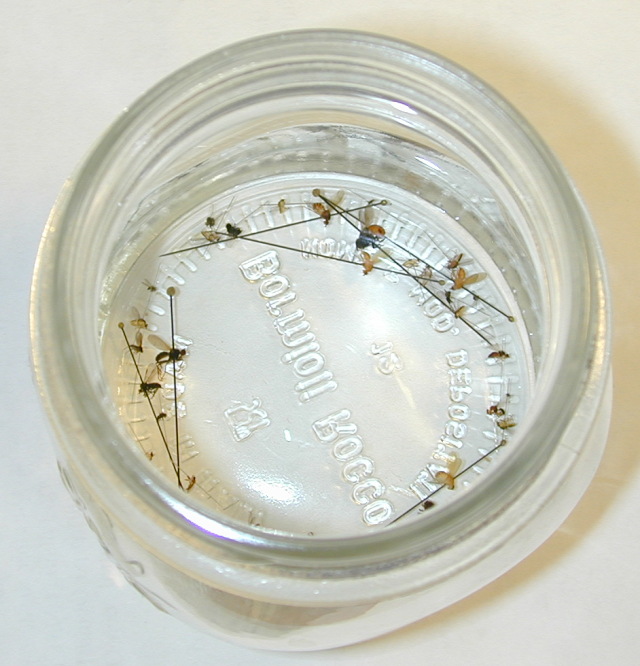 [118.99Kb] Kahis |
| Kahis |
Posted on 11-03-2008 19:28
|
|
Member Location: Helsinki, Finland Posts: 1999 Joined: 02.09.04 |
Opening wings agains a slip of paper
Kahis attached the following image: 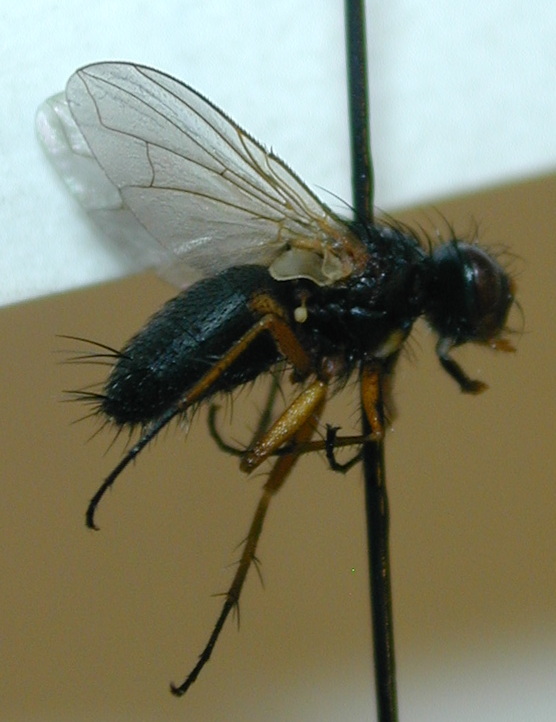 [107.17Kb] Kahis |
| Kahis |
Posted on 11-03-2008 19:33
|
|
Member Location: Helsinki, Finland Posts: 1999 Joined: 02.09.04 |
Style 2: micropinned agromyzids waiting for their bath
Kahis attached the following image: 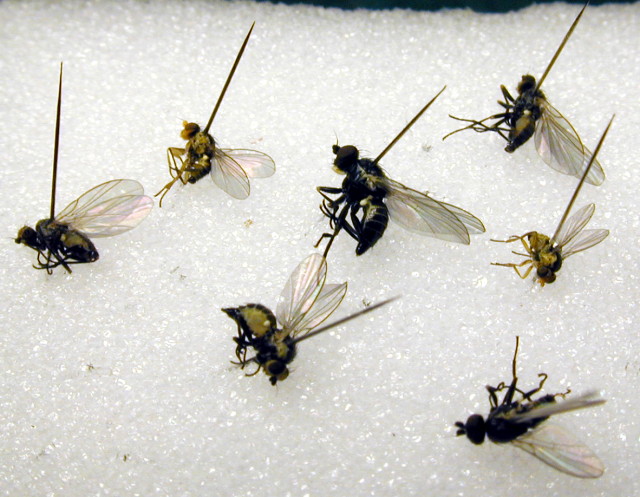 [101.65Kb] Kahis |
| Kahis |
Posted on 11-03-2008 19:35
|
|
Member Location: Helsinki, Finland Posts: 1999 Joined: 02.09.04 |
Results: Sapromyza (Lauxaniidae). The wings are open and undamaged, but slightly 'wavy', a typical result for style 1.
Kahis attached the following image: 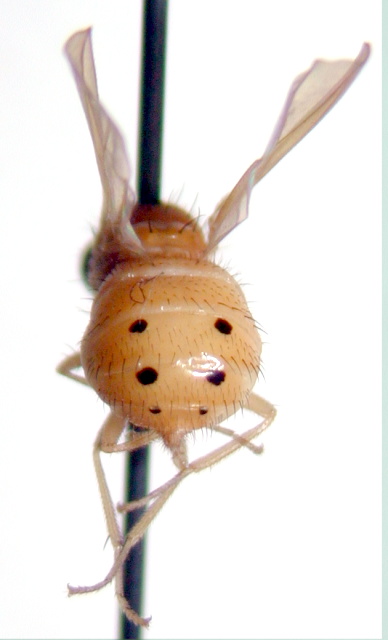 [52.27Kb] Kahis |
| Nikita Vikhrev |
Posted on 11-03-2008 19:46
|
|
Member Location: Moscow, Russia Posts: 9459 Joined: 24.05.05 |
I do prefer fresh pinned flies. But life is life and I have to deal with material from alcohol too. An additional problem I discovered is: most of bristles on Muscidae head and scutum are broken. What tubes and way of its storage may be recomended for storing flies in field, during trip and posting, please? Nikita Vikhrev - Zool Museum of Moscow University |
|
|
|
| Jump to Forum: |




